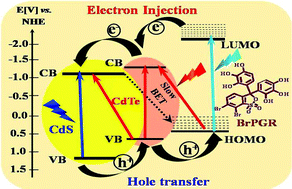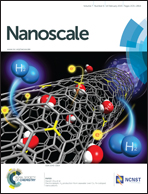Cascading electron and hole transfer dynamics in a CdS/CdTe core–shell sensitized with bromo-pyrogallol red (Br-PGR): slow charge recombination in type II regime†
Abstract
Ultrafast cascading hole and electron transfer dynamics have been demonstrated in a CdS/CdTe type II core–shell sensitized with Br-PGR using transient absorption spectroscopy and the charge recombination dynamics have been compared with those of CdS/Br-PGR composite materials. Steady state optical absorption studies suggest that Br-PGR forms strong charge transfer (CT) complexes with both the CdS QD and CdS/CdTe core–shell. Hole transfer from the photo-excited QD and QD core–shell to Br-PGR was confirmed by both steady state and time-resolved emission spectroscopy. Charge separation was also confirmed by detecting electrons in the conduction band of the QD and the cation radical of Br-PGR as measured from femtosecond transient absorption spectroscopy. Charge separation in the CdS/Br-PGR composite materials was found to take place in three different pathways, by transferring the photo-excited hole of CdS to Br-PGR, electron injection from the photo-excited Br-PGR to the CdS QD, and direct electron transfer from the HOMO of Br-PGR to the conduction band of the CdS QD. However, in the CdS/CdTe/Br-PGR system hole transfer from the photo-excited CdS to Br-PGR and electron injection from the photo-excited Br-PGR to CdS take place after cascading through the CdTe shell QD. Charge separation also takes place via direct electron transfer from the Br-PGR HOMO to the conduction band of CdS/CdTe. Charge recombination (CR) dynamics between the electron in the conduction band of the CdS QD and the Br-PGR cation radical were determined by monitoring the bleach recovery kinetics. The CR dynamics were found to be much slower in the CdS/CdTe/Br-PGR system than in the CdS/Br-PGR system. The formation of the strong CT complex and the separation of charges cascading through the CdTe shell help to slow down charge recombination in the type II regime.


 Please wait while we load your content...
Please wait while we load your content...